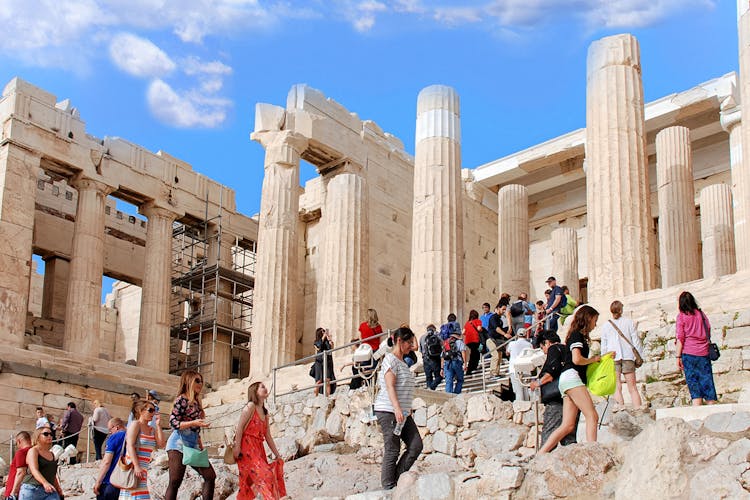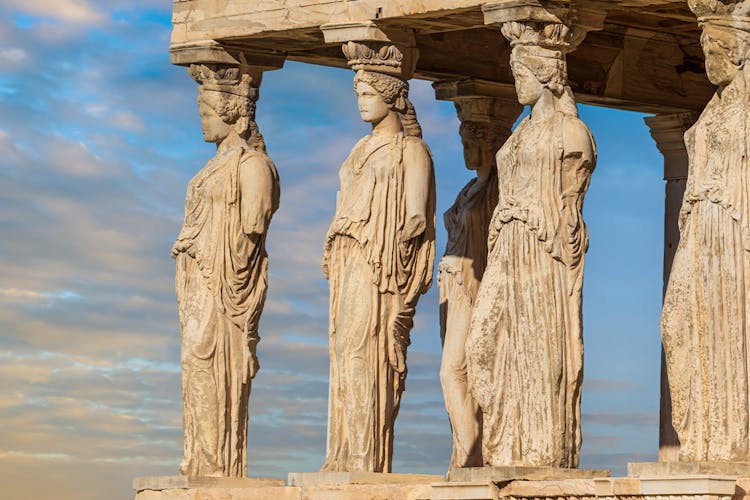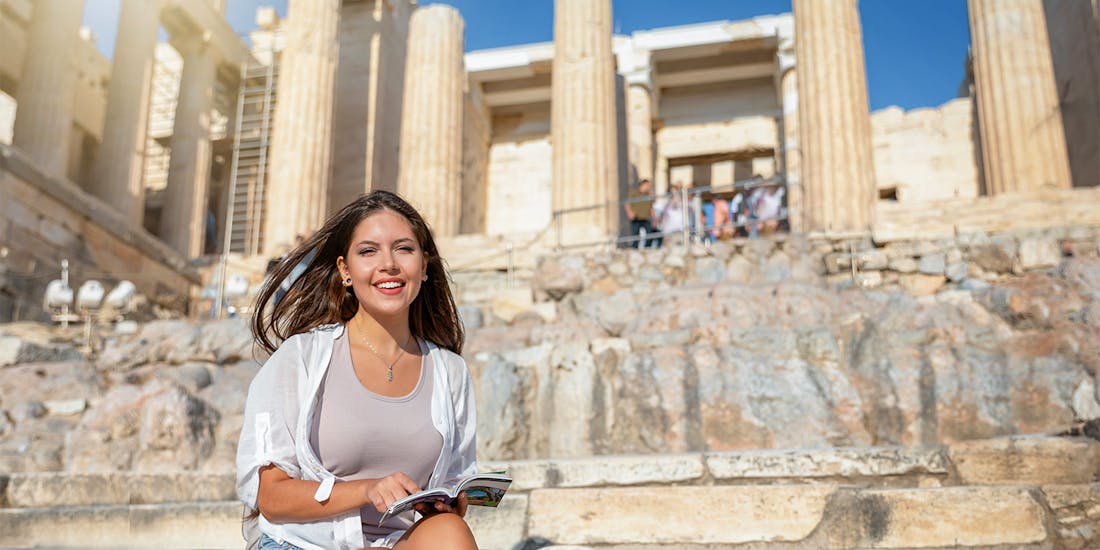Did you know that Athens is named after the Greek goddess of war, Athena? As the legend goes, Athena and Poseidon fought over the right to name the city. The people decided Athena should be the one. And that’s how Athens came to be called. While it is considered to be a myth, it seems believable since you can find many temples dedicated to the goddess of war in Athens. The
Acropolis is one of them and one of the most prominent ones!
In this blog, we're gonna take you on a journey through the Acropolis and explore its top highlights – Parthenon, Temple of Athena Nike, Propylaea, Erechtheion, and the Odeon of Herodes Atticus. We'll also give you some inside tips to help you make the most of your visit to this iconic site.
Why you must visit Acropolis

- Architectural Significance:
From an architectural perspective, Greek Architecture was so influential that ancient Rome’s architecture and Italy had significant traces of it. And more so, in the later periods, it influenced the West as well!
But did you know that 3 main types of Classical Greek architecture led to the creation of such magnificent temples and monuments that still stand today? Classical Greek architecture is based on 3 orders called: the Doric order, the Ionic order and the Corinthian order.
Monuments constructed in the Doric order’s style consisted of a circular cushion placed on top of the column that holds the monument. Going a step further, the Ionic order followed the same except the circular cushion had much more intricate designs carved on it. Lastly, the Corinthian order had cushions placed on top of the pillar which resembled a bell-shaped bowl with double-row acanthus leaves.
Now, when you visit the Acropolis and other Greek monasteries, you can identify which order was used to create a monument! - Iconic landmark and bucket-list experience: Designated as a UNESCO World Heritage site in 1987, the Acropolis is one of the most popular and easily recognisable landmarks of Greece. Visitors flock from all over the world to witness this beauty. An ancient ruin that has survived over several centuries and was restored in the 1970s, it’s truly a sight to behold. So, tick-mark your Greece trip with this bucket-list experience of visiting the Acropolis!
Tickets
Elevate your experience to have the best tim you can with the guided tour Acropolis tickets!
Acropolis - Top monuments you need to visit
1Parthenon
The most recognised monument from Greece and one of the most treasured national monuments - the Parthenon! Sitting atop the Acropolis in Athens, the temple was constructed around 447 and 423 BC as an ode to the Goddes of War - Athena. The Parthenon occupies a very distinct place in Greek mythology like the Trojan War and for historical purposes as well! It has truly stood the test of time for surviving through different wars and natural disasters. The marble-based monument was severely destroyed in the Persian invasion due to blasts and whatnot. Thankfully, restoration for the current state of the Acropolis began in the 1970s! While people get confused between the Acropolis and Parthenon for being 2 different sight-seeing landmarks, they're essentially infused together. So when you’re planning your visit to the Acropolis, you’ll get to see both!

2The Temple of Athena Nike
The Temple of Athena Nike is the smallest temple that was built atop the Acropolis, on the southwest corner of the cliff. Being constructed on the Ionic order of classical architecture, the temple has only 4 columns to it and is made up of stunning Pentelic marble. Historically speaking, despite being at the forefront and being susceptible to attacks from enemies, the temple’s position served to be useful as a defence. Evidence also suggests that the Temple of Athena Nike was a place of worship as it was the house of the deity, Athena! Not all had the privilege to enter this sacred temple as that was only reserved for the Priestess who was of high status in Greek society.

3The Propylaea
In Greek classical architecture, it is the main gate or entrance of the fortified Acropolis! The Propylaea of the Acropolis in Athens is the best-preserved entrance among all such gates in Greece! The purpose of adding such elements was to create a line of defence in case of an attack.

4Erechtheion
Named after the mythical king, hero and founder of Athens - Erechtheion, this temple was constructed in the final years of the 5th century! The Erechtheion replaced the old temple of Athens Polias, which was destroyed by the Persians. Considered one of the most complex structures ever built in the Acropolis – it deviated from the traditional architecture of symmetrical pillars. Instead, you can see figures of individuals in the form of pillars. It houses several deities within one roof, unlike other temples that are dedicated to a specific god. The Erechtheion preserves the wooden sculpture of Athena in the upper half while the lower half preserves the shrines of Poseidon-Erechtheus, Hephaistos and Boutes.

Pro tip: Look for the depictions of the fight between Poseidon and Athena for control over Athens. And as legend says, you can see the mark left by Poseidon’s bolt on the rock!
5Odeon of Herodes Atticus
The Odeon of Herodes Atticus is an ancient theater on the southwest slope of the Acropolis of Athens, Greece. It was built in 161 AD by Herodes Atticus with a seating capacity of around 5,000. The theater is famous for its acoustics and is used for cultural events, including the Athens and Epidaurus Festival every summer!

Inside Tips

- Try your best to arrive early during the summer season: It’s going to get really hot as the day progresses, especially during summer. The Acropolis opens at 8am, so ensure you get there early to beat the heat and avoid the crowds! You can skip long lines as well.
- Wear comfortable footwear: Plenty of tourists don’t pay heed to wearing comfortable footwear and regret it later! Since there will be a lot of walking and climbing to do, ensure you wear the right shoes and avoid flip-flops and heels.
- Stay Hydrated: Doesn’t matter if you’re climbing up the Acropolis or going to the beach, you need to stay hydrated everywhere! Carry water bottles, juice boxes, energy drinks and or anything else you can think of to quench your thirst!
- Respect the Rules: Always respect the rules and regulations set in place, when you’re visiting a new place. The Acropolis isn’t an exception. Be mindful of the rules, like not touching or climbing on the ancient ruins, and refrain from smoking or littering on the site.
- Dress code: The general rule while entering Greek monasteries requires both men and women not to wear sleeveless tops and their knees covered. However, the Acropolis is an exception to the dress code rule. Just ensure you feel comfortable in whatever you wear, based on the season.
- Spend a good amount of time: Go early, stay and admire the beautiful Acropolis. Ample time to learn about the history of the place, a bit about its architecture, soak in the view and take Instagram-worthy pictures. We all need a good picture, right?
- Photography: Photography at the Acropolis is allowed, but carrying drones are prohibited!
- Visitors with physical disabilities: Parts of the Acropolis are wheelchair accessible. The landmark also has an elevator to access Acropolis Hill.


